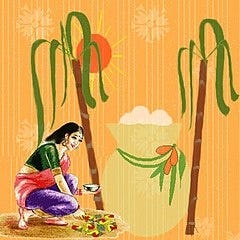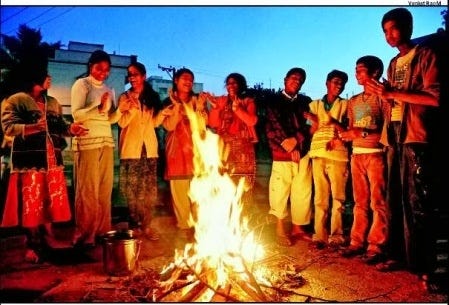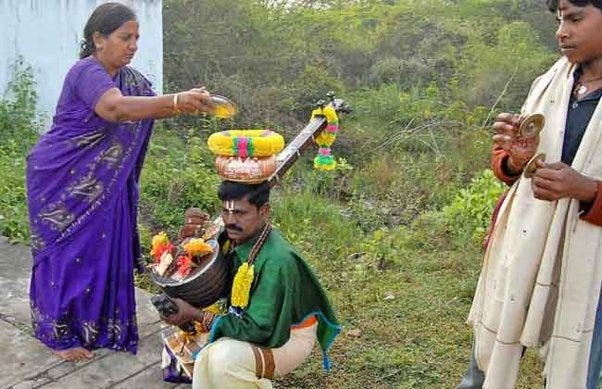One of the major festivals in the Telugu states of Andhra Pradesh and Telangana, is Sankranti, often called as Makara Sankranti. Along with Ugadi, Vinayaka Chaviti, Deepavali, Dasara, it is one of the most important festivals for Telugu speaking people. Essentially a harvest festival, it is celebrated primarily in the rural areas. It is primarily meant to celebrate the start of the harvest season and also the ending of winter too in a way.
One thing we need to understand is that Sankranti, occurs throughout the year. It basically means transmigration of the Sun from one Rashi( a Zodiac constellation) to another. In most of the regional calendars which are primarily sidereal solar , Sankranti, marks the beginning of a new month.However the Bengali and Assamese calendar mark Sankranti as the ending of a month. What we celebrate as Sankranti is primarily Makara Sankranti, when the sun transitions into the Makara constellation( Capricorn).
It also marks the start of Uttarayana, when it is believed that the Sun moves towards the Northern hemisphere, and lasts from January to July. While Makara Sankranti is undoubtedly the one that is celebrated most, there are couple of other Sankrantis too which are of equal significance. One is the Mesha Sankranti, when Sun is believed to move into the Mesha( Aries) constellation, and this actually marks the start of the New Year in the Hindu calendar. It is also the period, when regional new year festivals like Baisakhi( Punjab), Pana Sankranti( Odisha) and Pohela Baisakh(Bengal) are celebrated. Dhanu Sankranthi is celebrated on the first day of the month of Pausha( December-January) primarily in Bhutan and Nepal.
Sankranti is often associated with the Winter Solstice in India, which scientifically speaking is the longest night and the shortest day of the year. Basically what happens here is that as the Earth orbits the Sun, the hemisphere that was facing away from the Sun, experiencing winter, will now face towards the Sun, marking the start of summer. For farmers, it is a crucial time, as it marks the end of the long winter, and beginning of the summer, and a new harvest season.
As per Hindu belief, the Dakshinayana( Southern journey) of the Sun ends here, and it’s Uttarayana( Northern journey) towards the Tropic of Cancer, begins. This could be the reason why unlike other Hindu festivals, Makara Sankranti usually falls on a fixed date, January 14 or 15.
Basically for most Telugu people, Sankranti is the time, they make the trip to their native village or home town, wherever they are staying in India or the world. In a sense, it is the time, most go back to their roots, acquaint themselves with their native traditions. And apart from celebrations, it is also a time when many Telugu people also pay respects to their departed ancestors or near and dear ones. In both Andhra Pradesh and Telangana, the festival is celebrated for 4 days- Bhogi, Makara Sankranthi, Kanuma and Mukkanuma.
Bhogi
The first day is called as Bhogi, it is the day preceding Makara Sankranthi. It is the day when people dispose off their old belongings, which are not being used in a huge bonfire. Called as Bhogi Mantalu( fires of Bhogi), these bonfires serve as a bonding purpose too for family and community members to huddle around. It is also quite a good way to beat the winter cold.
The bonfire also symbolizes the discarding of old habits, vices, material attachments in the fire of knowledge. It is also called as Rudra Gita Gyana Yagna, and represents the realization and transformation of the soul.
Another feature of Bhogi is showering small kids less than 3 yrs old with the Regu Pallu( the jujube fruit). It is done to ward off the evil eye, and lot of sweets, are prepared, distributed on this occasion like below. In rural areas landlords give special gifts to their workers on this date.
Makara Sankranti, the main festival falls on the 2nd day, also called the Pedda Panduga( Big Festival), it is the time when people wear new clothes, pray to God and also offer food to their departed ancestors. It is also the time, when women and young girls draw the muggulu( Rangoli) with different patterns and colors. It is one of the occasions when you can see most young Telugu girls dressed up in the traditional langa and voni( a kind of half saree).
Another notable feature is the Haridasu( literally meaning Servant of Hari), who goes from home to home, singing songs of Lord Vishnu, with a pot on his head. The ladies of the home, then offer him rice and some alms.
Kanuma on day 3 is when the cattle are worshiped. Being a rural festival, cattle is very important to the farmer’s lives there. A line from an old Telugu song goes as follows
“Paaliche govaluku pasupu kumkum, pani chesi basavana ku patri pushpam”
Loosely translated it means “Haldi and Kumkum to the cows that give milk, and fruits and leaves to the hard working bulls”. It is a reference to the fact, that while the cows are meant for giving milk, the bullocks are meant for the harder tasks like pulling carts or ploughing the fields. While the cows are worshiped with a sindoor put on their foreheads, the bulls are decorated with colorful clothes and taken in a procession from home to home, while it’s owner plays the music on his shehnai.
The 4th day is called as Mukkanuma, which is when farmers offer prayer to the elements like soil, rain, fire for helping with the harvest, as also the local village goddess( often called Ammavaru). It is also the day when people have meat dishes, they are not eaten on the other 3 days in Coastal Andhra.
Apart from that we have other activities like kite flying, and cock fighting( mainly in Coastal Andhra villages).
Source










